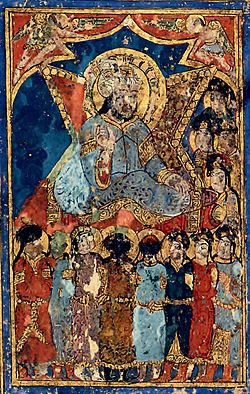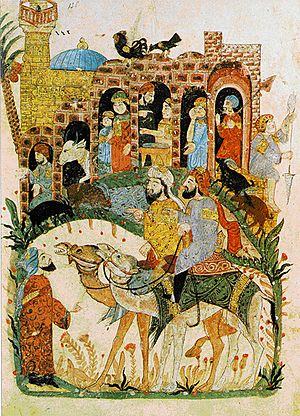Al-Hariri of Basra facts for kids
Quick facts for kids
Al-Hariri
الحریری البصری |
|
|---|---|

Possible depiction of al-Hariri, in the Maqamat of al-Hariri, 1237 CE edition, probably Baghdad.
|
|
| Born | Abū Muhammad al-Qāsim ibn Alī ibn Muhammad ibn Uthmān al-Harīrī أبو محمد القاسم بن علي بن محمد بن عثمان الحريري 1054 Al-Mashan Village, near Basra, Abbasid Caliphate, now Basra Governorate, Iraq |
| Died | 10 September 1122 (aged 68) Basra, Abbasid Caliphate, now Basra Governorate, Iraq |
| Occupation | Arab Poet, writer, Scholar of Arabic language, Official of Seljuqs |
| Notable works | Maqamat al-Hariri مقامات الحريري |
Abū Muhammad al-Qāsim ibn Alī ibn Muhammad ibn Uthmān al-Harīrī (Arabic: أبو محمد القاسم بن علي بن محمد بن عثمان الحريري), often called al-Hariri of Basra, was a famous Arab poet, language expert, and government official. He lived from 1054 to 1122.
He is best known for his book Maqamat al-Hariri, also known as the 'Assemblies of Hariri'. This book is a collection of about 50 stories. They are written in a special style called Maqama, which mixes poetry and fancy prose.
For over 800 years, Al-Hariri's Maqamat has been seen as one of the most important books in Arabic literature. It is considered a treasure, second only to the Koran and ancient Arabic poems. Even though Al-Hariri didn't invent the Maqama style, he made it into a true art form.
Contents
Who Was Al-Hariri?
Al-Hariri was born in 1054 AD and passed away in his hometown of Basra on September 10, 1122 AD. He might have been born in a village called Mashan, near Basra. His family owned a palm tree farm there.
His name, al-Hariri, likely comes from his family's connection to silk. They might have been silk makers or merchants in Basra. He was very proud of his Arab family history.
His Life and Education
Al-Hariri's family was very wealthy. This allowed him to get an excellent education. He studied law and later became an official writer for the government. He was a high-ranking official.
He split his time between Basra, where he had his businesses, and Baghdad, where he worked on his writing.
How He Wrote His Famous Stories
Al-Hariri is most famous for his Maqamat al-Hariri. This book shows off his amazing skill with words. It has 50 short stories, written in a very fancy style. Scholars used to memorize these stories by heart.
There are different stories about how Al-Hariri got the idea for his Maqamat. One popular story comes from his son. It says that Al-Hariri was sitting in a mosque when a poor man named Abu Zayd came in. This man was dressed in old clothes but spoke with incredible skill and beauty.
Abu Zayd told a sad story about his city being attacked and his daughter being taken. This powerful speech inspired Al-Hariri to write his famous collection of stories.
As soon as it came out, Al-Hariri's Maqamat became hugely popular. People traveled from far away, even from Spain, just to hear him read his stories. The book's other name, 'The Assemblies', comes from the fact that these stories were read aloud to groups of people.
Even during Al-Hariri's lifetime, his work was so important that people memorized it. They would recite it in public and write notes about it. Al-Hariri himself would read his Maqamat to learned audiences. This was the main way books were shared back then.
When Al-Hariri had written 40 of his stories, he gathered them into a book. He went to Baghdad, expecting a big welcome. However, some people accused him of copying the work from another writer. To test him, a leader asked Al-Hariri to write a letter on a specific topic.
Al-Hariri wasn't good at writing quickly on the spot. He needed quiet time to create his stories. Even though he tried, he couldn't write anything and felt ashamed. To clear his name, he went back to Basra. There, he wrote ten more stories in the following months.
Al-Hariri was a short man with a beard. He would often pull at his beard when he was thinking deeply. He wasn't considered very handsome. When visitors seemed put off by his looks, he would tell them, "I am a man to be heard, not seen."
The Amazing Maqamat Stories

For more than eight centuries, Al-Hariri's Maqamat has been seen as the greatest treasure in Arabic literature after the Koran.
The Maqama style was first created by Badi' al-Zaman al-Hamadani. But Al-Hariri took this style and made it into a major form of literature.
Al-Hariri's Maqamat has 50 stories. They are told by a character named Abu Zayd to Al-Harith, who is the narrator of the book. Abu Zayd is a traveler and a clever trickster. He uses his smarts and amazing speaking skills to get by. The book uses a lot of the language spoken by desert Arabs, including their sayings and clever expressions.
What Makes His Stories Special?
Al-Hariri's Maqamat uses many clever writing tricks. In one story, called "the reversal," sentences can be read backward. This gives each part an opposite meaning! In another story, the 26th Maqama, called the "Spotted," the main character writes a special letter. In this letter, a letter with a dot is followed by a letter without a dot, and so on.
Like most books from that time, Maqamat were meant to be read aloud to a group. Often, these oral tellings were made up on the spot. However, Al-Hariri wrote his stories carefully in private. He wanted them to be read exactly as he wrote them, without any changes.
His work was even translated into Hebrew by Al-Ḥarizi. This translation, called Maḥberet itiʾel, greatly influenced Al-Ḥarizi's own stories.
Other Writings by Al-Hariri
Many of Al-Hariri's letters have survived. He also wrote some poems called kasidas, which used a lot of alliteration (words starting with the same sound). He also wrote two books about grammar:
- Durra al-Ghawwas – The Pearl of the Diver Being a Treatise of the Mistakes [in Arabic Grammar] Committed by Persons of Rank – This book is a collection of common grammar mistakes, written in verse.
- Mulhat al-Irab – The Beauties of Grammar – This is a collection of poems about grammar.
How His Books Spread Around the World
Many copies of Al-Hariri's work were made by different Islamic rulers. This was because kings often ordered copies of famous books for their own libraries. By the 13th and 14th centuries, the book was translated into many Middle Eastern languages, like Hebrew and Turkish.
Some of the first copies and inspired works in European languages appeared in Spain as early as the 1200s. But people in the Western world didn't really discover his work until the first Latin translations came out in the 1600s.
During Al-Hariri's lifetime, his books were published without any pictures. However, starting in the early 1200s, illustrated versions of the book began to appear. We know of eleven different illustrated editions today. One of the oldest and most famous illustrated versions was made by al-Wasiti in 1236. It is now kept in the Bibliothèque nationale de France in Paris.
The most famous translation of his Maqamat into German was by the poet Friedrich Rückert. He tried to copy the rhymes and wordplay of the original Arabic. The main English translation was done in the 1800s by Thomas Chenery and Francis Joseph Steingass.
Hundreds of printed versions of the Maqamat exist today. Some important editions and translations include:
- Friedrich Rückert (trans), Die Verwandlungen des Abu Seid von Serug, oder die Makamen des Hariri, Cotta, 1837 (in German)
- Thomas Chenery and Francis J. Steingass (trans), – The Assemblies of Al-Ḥarîri: with an introduction about the life and times of al-Hariri (Translated from the Arabic with Notes Historical and Grammatical), Oriental Translation Fund, New Series, 3, 2 vols, London: Royal Asiatic Society, 1867 (in English)
- Amina Shah (trans.), The Assemblies of Al-Hariri: Fifty Encounters with the Shaykh Abu Zayd of Seruj, London, Octagon, 1980
- Theodore Preston (trans.), Makamat or Rhetorical Anecdotes of Al Hariri of Basra: Translated from the Original Arabic with Annotations, Cambridge: Cambridge University Press, 1850
- Michael Cooperson (ed.), Maqamat Abi Zayd al-Saruji by Al-Hariri, NYU Library of Arabic Literature: New York University Press, 2020. ISBN: 9781479800896 (Arabic edition)
- Michael Cooperson (trans.) Impostures by Al-Hariri, NYU Library of Arabic Literature: New York University Press, 2020. ISBN: 9781479810567 (English translation)
Images for kids
-
Al-Harith helps Abu Zayd to retrieve his stolen camel. Illustration for the 27th Maqama, from a manuscript in the Bodleian Library, Oxford.
See also


